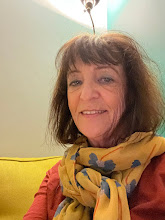 Barnett Newman never was on my list of preferred artists. Comforted by my ability to recognize the "zips" interrupting large fields of colors, when encountering one of his paintings at a museum or a gallery, I would walk by and, after a short glance, move on. I "knew" his work. The exhibition Barnett Newman: The Late Work at The Ménil Collection brought me to reconsider my approach and spend some time to reevaluate his legacy. Assembling not only paintings from the late period (1965-1970) and a few earlier works, the display includes also tools from the artist's studio, two sculptures and unfinished pieces.
Barnett Newman never was on my list of preferred artists. Comforted by my ability to recognize the "zips" interrupting large fields of colors, when encountering one of his paintings at a museum or a gallery, I would walk by and, after a short glance, move on. I "knew" his work. The exhibition Barnett Newman: The Late Work at The Ménil Collection brought me to reconsider my approach and spend some time to reevaluate his legacy. Assembling not only paintings from the late period (1965-1970) and a few earlier works, the display includes also tools from the artist's studio, two sculptures and unfinished pieces.The two first paintings on display start a dialogue with their similar but reverse patterns, echoing each other. Proof of the power of colors, the blue painting Untitled, 1970, generates serenity, while drama exudes from the fiery red of White and Hot,1967. The artist's tools are displayed in a glass case close by. Forget palettes and delicate brushes, they include paint rollers and other industrial devices. Facing each other, the next paintings are identical, but created at different periods, illustrating the technical growth and maturation of the artist. The first version of Be I was made in 1949 with oil based paint and the second in 1970, with acrylic. The only vertical zip is precisely in the middle, generating a diptych-type effect. The contrast is striking with, on one side, a flat, dull painting and the other, a bright, radiant, warm version. Nearby, Here I, 1959, standing on a pedestal reminded me of Cy Twombly's sculptures with its raw material covered with white plaster and its simple rough shape.
 One room is dedicated to earlier works from the fifties, including Primordial Light, 1954, Ulysses, 1952, Day Before One, 1951, and an untitled wall sculpture from 1959, minimalist in shape, juxtaposing red and black. The paintings' titles provide a clue when looking at the compositions. For example, Ulysses with its two-toned blue separated by a vertical black line evokes a seascape, the sky and infinity. The main room gathers the late pieces like Midnight Blue, 1970, from the Museum Ludwig in Cologne, or Shimmer Bright, 1968, a turquoise variation from the Metropolitan Museum of Art. The display is arranged by colors, and one wall is dedicated to black and white compositions How II, 1967 next to White Fire IV, 1968. The second sculpture, Here III, 1965-66, is a smaller version of Broken Obelisk which can be seen near the Rothko Chapel further down the street. The three unfinished paintings from 1970 in the last room were found in the painter's studio upon his death and provide a melancholic conclusion to the visit along a few sketches, photographs of the artist's studio and the cover of the October 1971 issue of ARTnews featuring Midnight Blue.
One room is dedicated to earlier works from the fifties, including Primordial Light, 1954, Ulysses, 1952, Day Before One, 1951, and an untitled wall sculpture from 1959, minimalist in shape, juxtaposing red and black. The paintings' titles provide a clue when looking at the compositions. For example, Ulysses with its two-toned blue separated by a vertical black line evokes a seascape, the sky and infinity. The main room gathers the late pieces like Midnight Blue, 1970, from the Museum Ludwig in Cologne, or Shimmer Bright, 1968, a turquoise variation from the Metropolitan Museum of Art. The display is arranged by colors, and one wall is dedicated to black and white compositions How II, 1967 next to White Fire IV, 1968. The second sculpture, Here III, 1965-66, is a smaller version of Broken Obelisk which can be seen near the Rothko Chapel further down the street. The three unfinished paintings from 1970 in the last room were found in the painter's studio upon his death and provide a melancholic conclusion to the visit along a few sketches, photographs of the artist's studio and the cover of the October 1971 issue of ARTnews featuring Midnight Blue.It is a difficult task to describe paintings which physicality needs to be experienced, and photographic reproductions are inadequate to convey the depth of their compositions. The exhibition creates an environment conducive to a full appreciation of the artist's legacy with its carefully selected works set in a chronological progression, disrupted only by didactic sidelines underlining subtle changes in techniques or medium. The bare setting of the rooms, with a bench in the center and soft lightning, provides plenty of space to immerse oneself in each large painting, allowing it to fill the visual field without distraction. The apparent repetitiveness of the paintings creates a language which triggers contemplation and reflection for the engaged viewer. They can provoke emotions and give a sense of infinity, thus reach a spiritual level. Finally, I was able to understand what the art critic Clement Greenberg describes in "Art and Culture" as "emphatic flatness", and feel the "colour breathes from the canvas with an enveloping effect".
At last, I "saw" Barnett Newman's work.
photographs were not allowed
photographs from Bing Images, Creative Commons licence for use
"Who's Afraid of Red, Yellow and Blue?", 1966
"Voice of Fire", 1967
"Broken Obelisk", 1962



